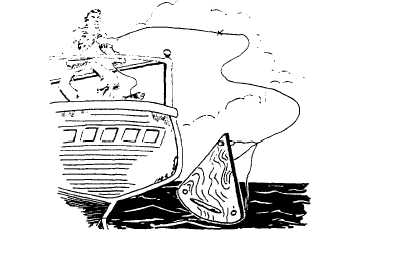| |
against damage is to prevent it. If damage occurs,
however, all hands must be trained in damage
control procedures to prevent the loss of the ship.
SUMMARY
In this chapter we introduced you to the major
structural components of ships and how they
affect the watertight integrity of the ship. We also
explained the system of numbering ship
compartments.
The four primary propulsion plants used by
the Navy are the conventional steam turbine,
diesel engine, gas turbine, and nuclear power
plant. We discussed the advantages and dis-
advantages of each type.
Last but not least, we talked about damage
control. Once again, remember that damage
control is an all-hands evolution.
KNOT
REFERENCES
Basic Military Requirements, NAVEDTRA
12043, Naval Education and Training
Program Management Support Activity,
Pensacola, Fla., 1992.
Principles of Naval Engineering, NAVPERS
10788-B1, Bureau of Naval Personnel, Navy
Department, Washington, D.C., 1970.
SUGGESTED READING
Bland, D. A., A. E. Bock, and D. J. Richardson,
Introduction to Naval Engineering, 2d ed.,
Naval Institute Press, Annapolis, Md., 1985.
Felger, D. G., Engineering for the Officer of the
Deck, Naval Institute Press, Annapolis, Md.,
1979.
THE TERM “KNOT” OR “NAUTICAL MILE”
IS USED WORLD WIDE TO
DENOTE A SHIP’S SPEED THROUGH WATER. TODAY, WE MEASURE KNOTS
WITH ELECTRONIC DEVICES, BUT 200 YEARS AGO SUCH DEVICES WERE
UNKNOWN.
INGENIOUS MARINERS DEVISED A SPEED MEASURING DEVICE
BOTH EASY TO USE AND RELIABLE:
THE “ LOG LINE. ” FROM THIS
METHOD WE GET THE TERM “KNOT. ”
THE LOG LINE WAS A LENGTH OF TWINE MARKED AT 47.33-FOOT
INTERVALS BY COLORED KNOTS.
AT ONE END WAS FASTENED A LOG
CHIP;
IT WAS SHAPED LIKE THE SECTOR OF A CIRCLE AND WEIGHT-
ED AT THE ROUNDED END WITH LEAD. WHEN THROWN OVER THE STERN,
IT WOULD FLOAT POINTING UPWARD AND WOULD REMAIN RELATIVELY
STATIONARY.
THE LOG LINE WAS ALLOWED TO RUN FREE OVER THE
SIDE FOR 28 SECONDS AND THEN HAULED ON BOARD. KNOTS THAT HAD
PASSED OVER THE SIDE WERE COUNTED.
IN THIS WAY THE SHIP’S
SPEED WAS MEASURED.
17-12
|

